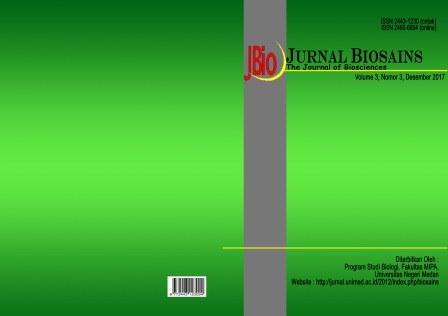PENGARUH FREKUENSI PENGGANTIAN SEKAM DENGAN KEHADIRAN EKTOPARASIT PADA MENCIT (Mus musculus)
DOI:
https://doi.org/10.24114/jbio.v3i3.9386Abstract
Tujuan dari penelitian ini adalah untuk mengetahui pengaruh frekuensi penggantian sekam terhadap kehadiran ektoparasit pada mencit yang dilakukan di Laboratorium Biologi Universitas Negeri Medan. Metode yang digunakan dengan memakai mencit dengan frekuensi penggantian sekam sekali dua minggu dengan 3 kali pengulangan dan menggunakan mencit peliharaan dengan frekuensi penggantian sekam sekali dua hari sebagai pembanding kehadiran ektoparasit pada mencit. Badan Mencit di usap dengan kapas yang sudah ditetesi alkohol dan disisir ke atas alkohol 70% sebagai koleksi ektoparasit kemudian di preservasi untuk di identifikasi. Hasil yang diperoleh terdapat ektoparasit jenis tungau dan pinjal untuk jenis tungau berasal dari anggota Laelapidae dan Xenopsylla cheopis pada mencit dengan frekuensi penggantian sekam sekali dua minggu, untuk itu dapat diperoleh kesimpulan bahwa kehadiran ektoparasit berpengaruh dengan frekuensi penggantian sekam. Kata kunci: Mencit, Ektoparasit, SekamDownloads
Published
Issue
Section
License
For Authors Jurnal Biosains agree to the following terms:
Authors retain copyright and grant the Jurnal Biosains (JBIO) right of first publication with the work simultaneously licensed under a Creative Commons Attribution License (CC BY-SA 4.0) that allows others to share (copy and redistribute the material in any medium or format) and adapt (remix, transform, and build upon the material) the work for any purpose, even commercially with an acknowledgement of the work's authorship and initial publication in JBIO (Jurnal Biosains)
Authors are able to enter into separate, additional contractual arrangements for the non-exclusive distribution of the journal's published version of the work (e.g., post it to an institutional repository or publish it in a book), with an acknowledgement of its initial publication in JBIO (Jurnal Biosains)
Authors are permitted and encouraged to post their work online (e.g., in institutional repositories or on their website) prior to and during the submission process, as it can lead to productive exchanges, as well as earlier and greater citation of published work (See The Effect of Open Access).


